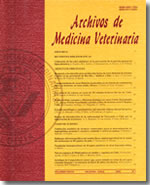Combined VEP and ERG protocol in beagle dogs to assess visual pathway functionality
Main Article Content
Abstract
Visual evoked potentials (VEP) and electroretinography (ERG) are known as objective and quantitative methods to analyse the functionality of visual pathways. Separately used in the ophthalmologic clinic to evaluate retina (ERG) or central visual pathways (VEP), this study designs a combined protocol with both techniques recorded in one session, and also proposes a normal data base for beagle. Twelve beagle dogs were used to design a 90-minutes protocol by using a mydriatic drug, anaesthetic protocol and a proper electrode placement. Flash stimulation technique was selected, and monocular stimulations were recorded. A large number of parameters regarding light stimulation, recording, amplification, and signal averaging were also controlled. The sequence of testing was: VEP, ERG scotopic and ERG photopic. Dogs were dark-adapted for at least 20 minutes to record VEP and scotopic ERG, and evaluated in a darkened room. Photopic ERG was tested with a prior 10 minutes light-adaptation, in an illuminated room. Characteristic waveforms were obtained. Four peaks were present and named as: P1, N1, P2, and N2 for VEP recordings. However, in ERG recordings, typical a-wave and b-wave were registered, but c-wave was not present. The proposed electrodiagnostic combined protocol in this study allows the assessment of the visual pathway integrity from retina to visual cortex in dogs. This procedure allows to collect the information in the most simple, shorter and less stressful manner for the patient.

